
Ah, promo images, so chic, so sexy...
Truth is there are tons of mid-priced headsets on the market, and each has something going for it, so let’s have a look at what makes the SX stand out.
In short, these are among some of the most comfortable headphones at this price we’ve tried. After a couple of hours of gaming, at a point when many of its competitors (yes, Turtle Beach Ear Force X1, we’re looking at you) suddenly start reminding you that your ears would much rather not be encased in foam and faux suede and your head would much rather you took the damn things off so as to give your neck muscles a bit of a rest, the SXs are still acting like they’re not really there, which makes a great deal of difference if you’re prone to headaches from too much headphone use.
Indeed, the comfort these cans offer is right up there with the best of them, and is their best feature by a long shot. Which, for serious yet skint audiophiles, must sound some sort of alarm bells, because away from their weight and comfort, the SXs are found wanting.
The mic, which is detachable and designed in such a way that it’s quite difficult to reattach while still wearing the headphones, comes up too short. Now, that doesn’t actually effect it picking up your voice, but it does effect your perception of what is right, leading your fingers to wander up to the side of your face time and again to pointlessly fiddle with it when no amount of fiddling will pull it closer to your mouth…

That is one chunky beast of a volume control...
What’s more irritating and most definitely a design flaw, is the jack socket connection direct to the 360’s control pad. One of the problems with the headset that comes with the console is that this socket eventually fails, especially if you unplug your headset after every session. The jack becomes loose and you lose connection. What most of these headsets do to get around that (since most manufacturers recognise that this is one of the reasons gamers look for a new headset) is have a specially designed jack plug that grips the controller in such a way as to make it impossible for the connection to be lost. But the SX’s socket just isn’t up to the job. It wobbles. So much so that the familiar crackle of static will boom out of the headphones whenever you accidentally knock the jack against yourself.
Yet this isn’t the SXs’ biggest fault. No sooner is it plugged into the USB socket and nestled atop your head, then the first audio cock up appears – a faint humming sound that is clearly audible at all volume levels. Of course, it’s too quiet to be a problem once you’re playing a game, as it’s lost behind the wall of noise; but when you’re playing an FPS and relying on every bit of audio for information on an enemy’s whereabouts, little things like distant hissing sounds really ruin the experience.
At the business end of things, the mid-ranges and highs are adequate for the money you’re paying, but the bass seems a little bit lacking. This is way more obvious when you use them to listen to music through your PC. In gaming terms, the loss of some meat on the bass bones might seem insignificant, but with Sharkoon blathering on about the inbuilt amp, you’d expect these headphones to deliver a deeper resonance than they actually do.
The size of the volume control, which feels huge, and the bizarre clip that comes attached to the wiring, detract from this headset’s overall appeal, even if the wiring itself looks like it’s of heavy duty spec. Have a close look though, because that thick wiring that runs up to the cans themselves contains both the jack and USB cabling, so it’s more than likely that the cabling is standard.
It’s a tough call, and one you’ll have to make on your own. The SXs are never going to blow the competition away on sound quality, and if your controllers’ jack plugs have been overly abused then these cans should be avoided; but if you’re looking for a fair priced set of headphones that won’t lead to headaches and sore ears, and you’re not overly concerned about that quiet hiss, then you can’t go far wrong with these babies. It’s a frustrating situation to be in, choosing comfort over delivery – kind of like the choice between a 1200cc sport bike or a gnarly custom trike. So what are you, a greasy biker too fat and old to be racing around after dark or a hip speed freak in custom leathers and shiny helmet?
]]>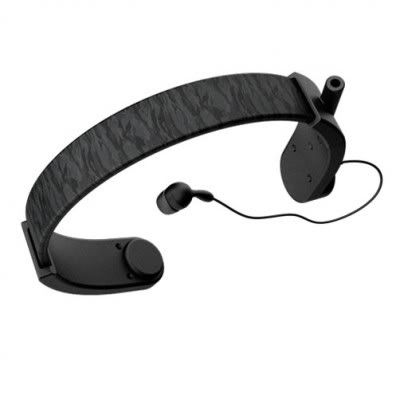 Gioteck enter the fray with the TX-1, a sturdy piece of hard plastic that grips tightly round 240 degrees of your neck and offers the one inner earpiece, laughably claiming that it’s an ambidextrous unit because you can flip it round and have the earpiece nestling in either ear. I’m left handed, but I have never in all my years heard of anyone being born left eared. Of course, you could be the sort of unlucky fellow who has lost the hearing in one ear, but the claim that this unit has been designed with that in mind is still laughable – can you even imagine what a throat mic that could only be used by the mono-eared might look like?
Gioteck enter the fray with the TX-1, a sturdy piece of hard plastic that grips tightly round 240 degrees of your neck and offers the one inner earpiece, laughably claiming that it’s an ambidextrous unit because you can flip it round and have the earpiece nestling in either ear. I’m left handed, but I have never in all my years heard of anyone being born left eared. Of course, you could be the sort of unlucky fellow who has lost the hearing in one ear, but the claim that this unit has been designed with that in mind is still laughable – can you even imagine what a throat mic that could only be used by the mono-eared might look like?
But anyway, throat mics primarily appeal to FPS fans since they come wrapped in that military swaddling usually found cradling army babies strapped to the back of muscle-bound marines as they storm the terrorist nursery.
The TX-1 doesn’t have much to distinguish it from the rest of the pack; like many others it runs directly off the controller it is plugged into and doesn’t need any more wires running from your console across the floor, which is why it only picks up voices from other players in-game. This, for me, is one of the major flaws. When I’m playing any multiplayer FPS game, I need to be able to hear where the gunshots and footsteps are coming from. And since I don’t have a wow-inducing surround sound set up in my living room, relying on the TV for valuable information like ‘are those footsteps I can hear getting closer coming from in front or behind?’ is pointless. I need the full, twin headphone, monty.
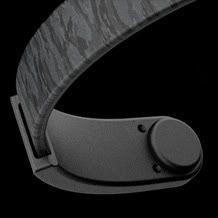
But if you’re intent on getting a throat mic (those chunky headphones feel like bricks strapped to your head after four hours of running and gunning and bring on the kind of headaches that can get you signed off work for a month), and have only ever experienced the free headset that comes with the console, then the TX-1 is a good place to start.
After a good week of FPS gaming, over a variety of games, I can safely say that the mic picks up everything you say, doesn’t cut out before, during or after speech and doesn’t make you sound like you’ve got a stoma.
Of course, the suggestion is that, like military style throat mics, these cheap gaming ones (the military ones cost in excess of £100) pick up vibrations from your larynx regardless of the volume you are speaking at, and thus cut out all extraneous noise. Now, if you’ve gone to the trouble of buying a proper one, then you can be sure that you will be heard even if you are whispering and playing a game while sat next to a Boeing 747 on take off. However, these gaming ones don’t actually pick up throat vibrations as they essentially contain a microphone inside the neck strap that picks up every sound around it, including, as happened to me, the sounds coming out of the TV.
 If you’re whispering, then you might be heard by your team mates, but they’ll hear it as a whisper and not a full bodied voice like you’d expect. This in itself is not a big problem – part of the appeal of the throat mic is the suspension of disbelief it brings to your FPS experience – but you should be aware that these mics are to gaming what the toy gun is to modern warfare.
If you’re whispering, then you might be heard by your team mates, but they’ll hear it as a whisper and not a full bodied voice like you’d expect. This in itself is not a big problem – part of the appeal of the throat mic is the suspension of disbelief it brings to your FPS experience – but you should be aware that these mics are to gaming what the toy gun is to modern warfare.
After a week of use, I quite enjoyed using the TX-1. I’ve been using some Turtle Beach headphones (complete with miles of cable sprawled across my floor) for the past two years, and though they’re great for focusing my attention on the battle around me, they’re heavy and they make me completely oblivious to anything my wife says (now how’s that for a sales pitch!). The TX-1 is, as you’d expect, extremely lightweight and compact. It gave me no headaches, kept me free of m’lady’s wrath (will you turn that bloody thing off and take the damned rubbish out!) and didn’t once trip the cat over with its wires.
However, there are some downsides. First and foremost is the fact that it’s not designed for those with large necks. I never realised I had a large neck until I felt the TX-1’s tight embrace around my throat and there wasn’t one single position on my neck, top middle or bottom, that made it feel any more comfortable to put on. Though this discomfort abated the more I became used to it, it still felt like some 70s fascist school teacher was gripping me round the throat from behind, pushing my face into a maths book and demanding to know why I hadn’t carried over the two and added it to the units column.
Also, because one of my controllers has been so badly abused over the years, the jack socket is flaky. This doesn’t present a problem for my Turtle Beach headset, which has a specially designed jack plug that holds it firmly in the right place; but the TX-1 has a standard jack plug and cuts in and out in that controller continuously.
 All told, I can see why many gamers might be interested in a throat mic, and I’d be happy to recommend this unit to them – but if they have a bigger than average neck, a shonky jack socket or a desire to hear the battle raging all around them, they’d be wiser to seek out a more appropriate mic/headphone peripheral.
All told, I can see why many gamers might be interested in a throat mic, and I’d be happy to recommend this unit to them – but if they have a bigger than average neck, a shonky jack socket or a desire to hear the battle raging all around them, they’d be wiser to seek out a more appropriate mic/headphone peripheral.

- Format: Xbox 360
- Unleashed: Out Now
- Publisher: Mastertronic
- Developer: PopCap
- Players: 1-2
- Site: www.popcap.com
We’re not sure if the cynic is here or in Popcap’s marketing department, but it is difficult to discern a reason why this compilation of some of Popcap’s online casual hits should be released when each and every one of them can be downloaded direct from XBLA for less than the full retail price of the disc.
Yes, there is an argument that there are gamers out there who don’t have a connection to the internet – but since this is a website, none of them are going to be reading this. On top of that, the full SRP (£29.99) is too much for a collection of games that had an original budget which couldn’t have factored in hard copy sales when they were originally made; because some of these titles date back to the early noughties.
Every bone in your body screams cash-in at Popcap Hits Volume 2, and some of them are hollering almost as loudly about the miserly amount of titles – four – on offer. We don’t for one minute believe this disc is full to the brim, and are sure they could have slapped a few more classic casual games onto it to make it a slightly more appealing package.
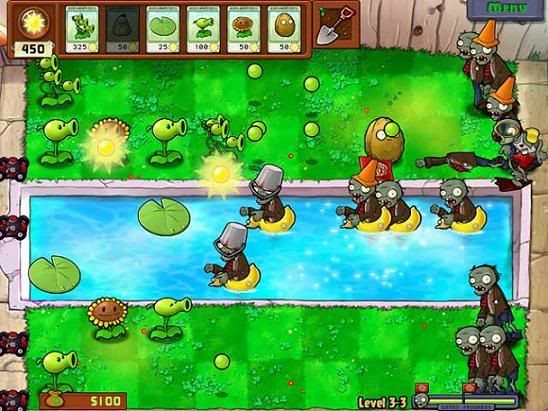
But it’s here, and we’re going to review it. So let’s start with the bad. You’d think that since these games are all on the one disc that when you quit out of one you would go straight back to the main menu to be able to start another, but that seems to have been like too much hard work for PopCap. Quit one game and you’re dropped right back to the dashboard, where you have to start the disc up all over again – extremely frustrating for those of you with messed up consoles that like to make you open and close the tray repeatedly before agreeing to boot any games up.
The inherent charm that PopCap inject into the majority of their titles is distinctly lacking on the game select menu; a half-baked screen that does nothing to draw you in. But, ignoring the huge gripes above, what of the games themselves?
There is only one title here that’s got a big enough addictive personality to squeeze more than half an hour’s gaming out of you, and that’s Plants vs Zombies. It’s a one screen tower defence game that was, quite rightly, a monster hit on the iPhone; with a charming, cutesy art style and a highly playable mechanic. Your home is under attack from zombies, six lanes of them, and you need to plant out some zombie slaying vegetation to keep them at bay. It doesn’t sound like much, but you try dipping into this game for a quick 20 minutes without winding up still sitting in your pants at two in the morning planting out mushrooms and pea shooters to destroy disco dancing zombie cannon fodder.

Feeding Frenzy 2 and, er, not Zuma.
As a downloadable game from XBLA, Plants Vs Zombies is superb, and if you take anything from this review, make sure it’s the decision to drop this into your hard drive and lose an evening or two inside its wonderful world of wackiness.
Of the other three titles, only Zuma has any decent track record. It’s been a life saver for many a bored office worker over the past decade, with its simple puzzle mechanic of shooting coloured balls out of a frog’s mouth into a chain of more coloured balls, destroying any chain of colours longer than three balls and temporarily halting the chain’s progress into the dead zone that awaits at the end of the run.
But there’s a world of difference between sitting at your desk wishing you weren’t actually there and sitting on your sofa wishing you were playing something with a bit more meat on its bones. At work, it takes about half an hour of playing Zuma before the boredom washes over you. At home it takes about three minutes. If you’ve ever played Zuma in the office, the last thing you want from your home console is to be reminded just how much you hate being at work…
 And it doesn’t get any better. Heavy Weapon is a lacklustre 2D, side-scrolling shoot ’em up that is reminiscent of Moon Patrol back on the Atari 2600. It’s so meh, it’s not worth going into detail over. Even online in the office, playing for free, it’s hard to muster up the will to keep going after you’ve been killed the first time. At home it’s impossible.
And it doesn’t get any better. Heavy Weapon is a lacklustre 2D, side-scrolling shoot ’em up that is reminiscent of Moon Patrol back on the Atari 2600. It’s so meh, it’s not worth going into detail over. Even online in the office, playing for free, it’s hard to muster up the will to keep going after you’ve been killed the first time. At home it’s impossible.
And bringing up the rear is the admittedly charming Feeding Frenzy 2, in which you start out as a very small fish that needs to eat smaller fish in order to grow into a bigger fish that can then eat even bigger fish. And so it goes on. Yes, it does look quite lovely, and it would no doubt keep younger children entertained for a while; but as a console game on a hard disc, it struggles to offer real value for money.
The only reason we would ever suggest picking this up is if you don’t have an internet connection at home and you’ve spotted the compilation on sale in a bargain bin for less than five quid. Plants Vs Zombies is a great game, but to pay full price for such a short and sweet title (made that little bit more bulky here with the addition of some unlockable mini-games) is one step too far.
]]>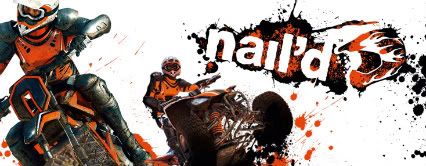
- Format: Xbox 360 (version reviewed), PS3, PC
- Unleashed: Out Now
- Publisher: Deep Silver
- Developer: Techland
- Players: 1
- Site: www.naild.deepsilver.com
If you don’t care for hardcore, perfect line racing games that get all intricate and fanatical about tyre pressure and weight ratios – but you do get a massive kick out of thrashing cars and bikes round tracks at stupid speeds and wiping out in stupendous style – Nail’d, you’d think, would be just your cup of tea.
Nail’d’s blend of over the top action and adrift from reality course design should, in theory, ring the bell so hard the clapper hangs off. And for the first half an hour, that’s exactly what it does.
 The controls are simple: accelerate, brake and boost sit on the triggers and the face buttons, and steering (both on the ground and in the air) is all on the left stick. And that’s it; bar the button to change the music there’s no need to touch anything else. Which is good, to start with, as the fight to keep your vehicle on the road is hard enough at times. Not because these ATVs and bikes are difficult to control; but because what is and isn’t track can be so difficult to distinguish that for a while, some will be wiping out almost continuously. And once you’ve got a handle on the course designs, the other major wipeout factor comes calling.
The controls are simple: accelerate, brake and boost sit on the triggers and the face buttons, and steering (both on the ground and in the air) is all on the left stick. And that’s it; bar the button to change the music there’s no need to touch anything else. Which is good, to start with, as the fight to keep your vehicle on the road is hard enough at times. Not because these ATVs and bikes are difficult to control; but because what is and isn’t track can be so difficult to distinguish that for a while, some will be wiping out almost continuously. And once you’ve got a handle on the course designs, the other major wipeout factor comes calling.
Nail’d’s unique selling point is its death defying jumps – we’re talking leaps of faith here where you hammer down the boost button and rocket blind off gigantic ramps, tipping your vehicle backwards and searching the screen for the landing point; which might be right in front of you but is just as likely to be 300 metres to the left or right. This is a big kick, for a while at least, which elicits the kind of joyous woo-hooing you’d expect from something so adrenaline pumpingly dangerous. But not for very long. After the initial rush that comes from near missing zeppelins and landing in the sweet spot, the jumping becomes just another part of the race, neither exciting nor out of the ordinary.
And why are there no stunts available? As the game progresses, a quick peek down the list of upcoming events shows that there are some tracks that are all about stunts, so you’d expect to be able to pull off a Superman or a Stale Fish with all the hang time available. But Nail’d doesn’t bother with that. As far as Nail’d is concerned, stunts mean perfect landings and being able to boost non-stop for eight seconds. Hardly what seasoned action racing fans expect as a definition.
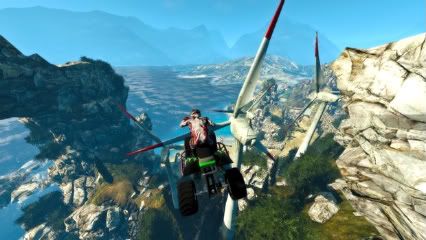 Look deeper into the way the game’s menus are set up and you can see that Nail’d is in need of some serious polishing. For example, each tournament is selected from a main menu – but once you’ve completed a race in that tournament, instead of being returned to that specific tournament’s menu screen you are popped right back out to the main menu. Sitting through the same load screen time and again after every completed race is a real chore, maddening when you know that it would have been very simple to sort these menus out.
Look deeper into the way the game’s menus are set up and you can see that Nail’d is in need of some serious polishing. For example, each tournament is selected from a main menu – but once you’ve completed a race in that tournament, instead of being returned to that specific tournament’s menu screen you are popped right back out to the main menu. Sitting through the same load screen time and again after every completed race is a real chore, maddening when you know that it would have been very simple to sort these menus out.
And then the inconsistencies in the actual racing become apparent. When you crash in Nail’d you don’t get a nice, gnarly wipe out animation, you get a load screen. Annoying enough, but even more annoying when you crash in the wrong bit of course and are plopped right in front of a jump ramp with no chance whatsoever of making it, meaning you crash again and sit staring at the very same load screen once more.
And that’s not all. Sometimes you will clip a tree and get totally nailed, other times you can hit a rock at full speed and bounce straight up into the air. Never mind that on the last lap you hit the very same rock at the very same speed and got totally destroyed.
 It’s not all bad. Downhill can feel more like you’re on a pair of skis – the sound of you ATV slipping and sliding down steep muddy banks is almost spot on Ski Sunday effects – and the speeds you can reach at full boost are pretty nifty, if you stay on course. It’s no doubt possible to slam your way round some of these tracks without taking your finger off the boost, if Nail’d keeps your interest long enough to master it.
It’s not all bad. Downhill can feel more like you’re on a pair of skis – the sound of you ATV slipping and sliding down steep muddy banks is almost spot on Ski Sunday effects – and the speeds you can reach at full boost are pretty nifty, if you stay on course. It’s no doubt possible to slam your way round some of these tracks without taking your finger off the boost, if Nail’d keeps your interest long enough to master it.
The multiplayer gives an extra dimension to the solo experience but it’s still the same game and, as if to highlight the lack of polish, the fact is that once you’ve selected a track to play on (only the host gets a say) there doesn’t seem to be any way other than quitting the game and starting again if you want to choose another track. Nonetheless, crossing the line 30 seconds before your friend never gets old.
Nail’d is a good laugh for a short period of time, that could have been a good game to play with some buddies round the same screen (if it actually had a split screen function); but for those looking for some long term commitment, Nail’d is about as likely to want to meet your parents as that date you had last week with the sex bomb whose ice breaker was, “I love one night stands, they’re so dirty”. Great to go to bed with, not so nice to see beside you in the morning.
]]>
- Format: Xbox 360 (version reviewed), PS3
- Unleashed: Out Now
- Publisher: Sega
- Developer: Platinum Games
- Players: 1
- Site: www.sega.com/vanquish.com

He's behind you!
On paper Vanquish is little more than a vide game by numbers: American good guys? Check. Evil Russian? Check. Robots? Check. Gruff male lead? Check. Gruffer male side-kick? Check? Massive weapons? Check? Sexy female support? Check. Outer space setting? Check. It reads like a multiple choice exam paper on gaming stalwarts. It goes on. Fire the game up and you’ll be struck by how much it resembles Halo. The lead character looks like a variant of Master Chief and the game takes place entirely on an orbiting space station in the shape of… a giant halo. And if there were nothing going for this game then we could all sign off here and go home, leaving a generic third person shooter in a puddle on the floor. But Vanquish is no more a poor man’s Halo than it is a bite-size Gears Of War. The parts might look like a bunch of gaming cliches held together with spit and vinegar, but as a whole they make a glorious, addictive game that never loses its suspension of disbelief
Flying out of the traps faster than a whippet with a jetpack, Vanquish hurls you into a manic gunfight that flashes by in less than seven hours at a near perfect pace. The plot is a simple one: with the planet’s population reaching 10 billion and its resources straining under the weight of demand, the Americans build a giant space colony. The Russians, now under the control of a military dictatorship, aren’t too happy about that and steam off into space to invade. Once there, they convert the space station’s power to make themselves a deadly super-weapon and launch a devastating attack on the US, destroying San Francisco in a matter of seconds. Naturally, the Americans want revenge and dispatch a vast army of space marines to give the Ruskies a land-of-the-free slapping. And here’s where you come in. Playing as Sam Gideon, researcher for DARPA (Defence Advanced Research Projects Agency) and designer of the Augmented Reaction Suit (an experimental combat suit that acts like a jumpsuit shaped tank), you’re packed off with your old sparring partner, Lieutenant Colonel Robert Burns – a man who makes Conan era Schwarzenegger look like Pee Wee Herman after a six month intensive weight loss regime – to wage war on those damn fascists. There’s more, but all you really need to know is that you and walking megalith Burns will be standing side-by-side as the enemy guns spew hot lead in your direction until one side remains.

Future space Russian Oligarchs all dress like this, don't you know…
The fact is that until you’ve reached a cut scene there’s no time to think about plot anyway. The game kicks off and you have to answer a question that haunts you from start to finish: find cover or get in there and kill? Gideon’s suit is so funky that he can hug the ground and blast around at inhuman speeds, allowing him to get right into the heart of the battle or escape quickly depending on the situation. He can also use that booster power to deliver deadly melee attacks or even to slow down time enough to give himself a life saving edge just when he needs it. Since the suit has only one meter bar, all of these abilities have to be used sparingly for, though it only takes a few seconds for the suit to recharge, it only takes a few seconds to get Sam killed too.
Much like the metal freak in Terminator 2, the arm of Sam’s suit is able to take on the form of any weapon, although it can only store three weapon configurations at any time. Weapons range from the basic shotgun right up to a bonkers LFN gun that burps out a slow moving ball of electronic death.
And yet, after all this, Vanquish still reads like a generic shooter. That’s because so far you’ve not played the game. You’ve not torn through a wave of robot soldiers and blown off the legs of a giant, gun toting, robot spider. You’ve yet to come face to face with a glowing humanoid with cloaking powers and a desire to tear your face off and eat it. These are just some of the boss type characters you’ll meet along the way, and every one of them is excellent, though none more so than the Unknowns. Imagine if Cool Spot had the power to gather all metallic objects about him like a suit of armour and, once dressed, could assimilate anything or anyone into his get up. That’s an Unknown, a brilliantly realised boss character that’s half hilarious and half nightmare.
Depending on your level of skill and the difficulty you choose to play on, Vanquish will take as little as four to eight hours to complete. Short, yes, but those few hours will be some of the best video gaming hours you’ll enjoy this year. From the set pieces through to the open battles, the breathtaking cut scenes to the superb details on each and every character, Vanquish doesn’t ever drop the ball. It’s an absolute pleasure to play through, the kind of game you stay up late on a Monday night to finish and then bunk off Tuesday to play through again.

Stealing base in outer space
There’s almost nothing to complain about in Vanquish, but not quite. Right in the middle of the frantic fighting there’s a mission where you have to switch to a sniper rifle and carefully take out a series of spotlights. Not that this part of the game sucks at all, it just feels out of place amongst all the immensely satisfying mayhem. And that’s it, the only gripe.
On paper, a game that does nothing to raise the profile of videogaming and adds bugger all to the genre, but in practice Vanquish is a superb example of why there’s no need to do either.
]]>
For a game that relies on atmosphere to ramp up the fear factor, demoing SAW II in a room that’s thick with the sound of gun shots from the various shooters and failing to provide headsets seems a colossal balls up. What it means is that the only impression you can get about the game comes from the visuals.
The demo kicks off with you slicing your face open to get at a key, which will unlock the bear trap that your head is stuck in. Sounds gruesome, huh? That it is. And didn’t practically the same thing happen in the first SAW? Graphically, it’s a bit off the mark. Every time someone tried it out, the scalpel blade sliced the face in a different spot, sometimes through the stitches, sometimes beneath them, sometimes above. And the blood didn’t always seep from the incision. Not an overly impressive start. The graphics look weak all over the place. The character you’re playing, detective Tapp’s son Michael, glides around the horror house looking for all the world like he’s floating on a cushion of air. Given the fact that you’re in a decrepit house chock full of junk this movement feels completely out of place, its unwarranted fluidity exacerbated by the lack of creepy audio.
The bear/face trap is a simple puzzle to solve; bash the button you’re prompted to until you’ve cut your face open wide enough to dig the key out and the game will do the rest for you. Then it’s on to the puzzle solving. It is, of course, little more than an extension of the first SAW game – there are plenty of beams to fall from, lots of nasty ways to meet your maker and room after room of puzzles to solve and goons to fight. But judging from the response of many who tried it out, there wasn’t much to keep a player interested. SAW II was one of the few games on show at Eurogamer where punters walked away before they’d finished the demo. Admittedly, some of them walked away because they just couldn’t solve the puzzle and a few sloped off before they’d even sliced their own cheek up and not because they were too freaked out by it but because the overwhelming feeling this little gruesome titbit evoked was one of total meh.
Much of the game had a take it or leave it feel. Most people were up for leaving it because the queues never grew over one man waiting, and plenty looked for a bit and left. Moving from room to room, searching for the codes to unlock the next door, then solving the resulting puzzle did not elicit much excitement in those we saw play through. In fact, take away the gory nature of each problem and you’re not left with much. However, there were moments that yanked on the interest bone. Crossing those beams, or rather failing to cross them and falling to your death, was pretty cool. In real life those beams wouldn’t pose too much of a problem, but in SAW II it’s no easy task. Besides which, making Tapp fall into the void was much more fun than letting him get his face mashed up by 200 nails.
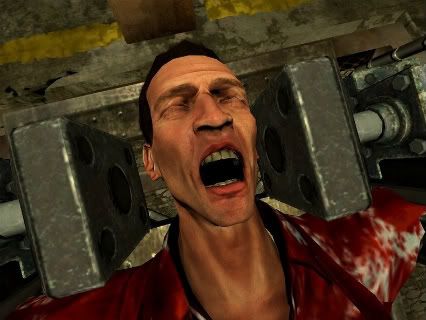 The one moment that actually caught me off guard, was when Tapp spies through a peephole in a door only to discover there’s a shooter on the other side, trained right on his eyeball (his eyes do come in for some rough treatment). Diving clear out of the way in the nick of time was a kick.
The one moment that actually caught me off guard, was when Tapp spies through a peephole in a door only to discover there’s a shooter on the other side, trained right on his eyeball (his eyes do come in for some rough treatment). Diving clear out of the way in the nick of time was a kick.
On the whole, SAW II comes across as a game that’s neither here nor there. Yes it’s violent, yes it’s sometimes infuriatingly puzzling, but for the most part it’s dull. Perhaps if it had been out in the main, all ages area of the hall there would be a steady procession of under 18s getting off on the violence; but in here, where everyone’s old enough to have digested a ton of horror movies, sitting with SAW II felt like being stuck at a party with the guy who’s only happy when he’s shocking people. Except no one’s ever shocked by his words, they’re just tired by them.
]]>
Apologies to anyone who queued for three hours to play Brink on Friday, specifically those queuing when I bunked the fence. I would not have done it had it not been for the comedic moment when a clan mate and I, having just asked the perimeter guard if there was a queue (it was tucked round the back and we didn’t see it at first), witnessed a lad slip under the cordon and plonk himself down on a stool, right in front of the foot soldier, who did nothing about it. That’s like a red rag to a bull in my eyes. Do it, said my brain. I did it. I regret it, but not as much as I would have regretted not trying this game out.
If I hadn’t seen Rage being demoed upstairs I would be calling Brink game of the show, but after a glimpse of the graphically beguiling expanse of id’s jaw-dropper, Brink will have to settle for playable game of the show.
Set on a floating island, Brink’s near future story, one that pits the island’s founders against the unwelcome newcomers who flocked to the Ark when the seas began to rise, has been written with both multiplayer and solo gaming in mind. We’re told that you can play Brink either way from the outset, blurring the lines between the two. What this means is that you can start the story off solo and, once you’ve become accustomed to the game, switch to multiplayer at any time, seamlessly.
Talking to Splash Damage’s Ed Stern, lead writer on Brink, the following morning (I busted a nut to get to the front of the queue Saturday morning for another go and still had a half hour wait) brought forth the fact that though there were eight screens to play on, each were split into a group of four, with four AI characters being thrown into the mix. I didn’t notice it at all, which goes some way to explaining how this solo/multiplayer balance is going to work. Go from solo campaign to multiplayer, and if there aren’t enough players online playing that specific chapter of the game, the blanks will be filled in by AI on both sides.
 Primarily the game is about the constant struggle between the haves and the have nots, a sort of class war for the eco warrior generation. You have a choice of playing either as the security forces trying to maintain the status quo or the renegades intent on bettering their lot. Imagine Rio De Janeiro if it were a floating island with the favelas at one end and the city proper at the other and you’ve got a good handle on the Ark’s geo-political structure.
Primarily the game is about the constant struggle between the haves and the have nots, a sort of class war for the eco warrior generation. You have a choice of playing either as the security forces trying to maintain the status quo or the renegades intent on bettering their lot. Imagine Rio De Janeiro if it were a floating island with the favelas at one end and the city proper at the other and you’ve got a good handle on the Ark’s geo-political structure.
But so far, aside from the nifty little multiplayer/solo blend, Brink sounds like your typical FPS, right? Damn, if there isn’t a lot more to it. Let’s take the classes. There are four options on either side: Medic, Soldier, Engineer, Operative. Soldiers, as you’d expect, are the gung-ho, charge in and shoot it, front line. They’re the ones to seek out when you need more ammo and they’re also the ones with the bag of grenades. Medics, naturally, can patch up their team mates when downed (when you’re all out of health you can choose to either call for a medic and wait to be revived where you are, or wait to join the next batch of reinforcements), or give them a health boost willy nilly. Engineers have the power to repair or build all manner of equipment and are supposed to be the tactical defense squad. Operatives seem to be created for the hardcore FPS player as it’s up to them to hack enemy defence systems and slip behind enemy lines to deliver recon intelligence. What’s more, they can steal a dead enemy’s identity, slipping on their clothes to wreak havoc from within their midsts.
Furthermore, like Battlefield Bad Company, each class scores leveling up points through their actions – medics for health boosts, engineers for boosting team mates’ weapon stats, and so on. Just simply running into a battle and shooting at everyone will not necessarily make you top scorer. In fact, the big points are scored through completing missions. And in Brink the missions are different for every player. Say you’re a medic still following the game’s plot and the main mission in that chapter is to stop the security forces from nabbing the top secret stuff your resistance boys had earlier nicked from them. The primary goal for everyone on your side is to protect that package. But every individual playing has their own specific objectives. So whilst you need to stop the enemy from getting that package, you also, as a medic, need to revive a particular team mate on the battlefield. And that’s not all. Calling up an objective wheel, you will be presented with a selection of missions to choose from. Though your primary objective is at the top, there are others that will also score you big points if completed.
These objectives are based on real time battlefield data; what class you are, where you are on the field of combat and in what condition you are in will affect your list of objectives. During the demo, I didn’t notice any changes in my objectives, but this is probably because everyone playing was more concerned with running headfirst into battle and blasting holes in each other. In the games that I played we, the resistance, successfully repelled the enemy attack, holding them at the first place we met until the clock ran out. But it didn’t matter much, the simple pleasures of shooting each other were enough for me and everyone else to enjoy.
 The ways in which you can play this game are many, then: alone, with a clan, with strangers, with just one buddy; straight up gun fight, tactical team game, covert operator. Follow the plot or ignore it completely and just head to the multiplayer maps. It’s really up to you.
The ways in which you can play this game are many, then: alone, with a clan, with strangers, with just one buddy; straight up gun fight, tactical team game, covert operator. Follow the plot or ignore it completely and just head to the multiplayer maps. It’s really up to you.
And for once in a shooter, the medic class is not limited to weak guns. In Brink all the guns are available to every class. Stern let slip a little nugget of info when he said that playing as the medic is the easiest way to level up because the points for reviving a player on the field far outweigh any kill scores.
But I’ve said too much, none of the above would matter if the game sucked, right? The game does not suck. Oh no. The game is formidable.
In this demo we were playing in an encampment made up entirely of shipping containers. The security forces were tasked with grabbing that package back and the resistance had to hold them off. Both times I played I was dropped into the resistance forces. We start out at a small base camp where you can switch class at any time in the game (it’s also possible to change classes at any of the bases on the map, as long as your team has captured it, a very welcome touch). I played as both a medic and an engineer, each could gain points from boosting team mates’ health and weapons simply by facing a character and hitting the X button when in range. I kept doing this, especially as the medic, watching my score increase, while at the same time mixing it up in the frantic gunfight. In each game there was a bottleneck where every player congregated to swap bullets and death. As the medic, you’d be surprised just how long you can last. Standing back, seeing comrades bite the dust, taking down their killers and then reviving them before the opposition regrouped was a serious buzz. If you’ve played Bad Company 2 you’ll know how much it sucked being a medic early on with an LMG that was essentially a spray and pray weapon. In Brink, the medics hold their own. I really didn’t feel like I was outgunned at the moments when I was centre stage, taking out a couple of enemies before I was shot up wasn’t luck or great skill so much as a balanced playing field. Okay, so maybe there was a smidgeon of skill involved.
The engineer, on the other hand, has different options. At one point I’d leveled up my character and could then build a gun turret and drop it onto the battlefield wherever I liked. That bottleneck was far less of a problem once I’d set it up, and we wiped the floor with the security side.
Exploring the map as much as I could in the short space of time, I found sneaky flanking routes, fixed gun placements, little peep holes that would, in any other FPS game, be perfect spots for snipers but in Brink are peep holes for all (there are no sniper classes! Ha! Eat that all you damned sniping dirtbags!). As an engineer, I managed to infiltrate the enemy base and capture it. My score kept on rising. In the end, the best I managed playing as a medic and reviving maybe six or seven resistance fighters, was third on the leaderboard, and I would most certainly have placed top if I’d remembered my primary objective. But, well, I got so into the shooting and the reviving that I forgot all about the objective wheel.
I also kept forgetting one of Brink’s other unique selling points, the SMART system. Standing for smooth movement across random terrain, it basically means that obstacles usually requiring you to hit a button when prompted can now be climbed, vaulted, hung off and jumped over fluidly. Holding down a shoulder button is all you need to do. Okay, so I’m running down a tight alley, at the end is a doorway about five feet off the floor. Since I’m holding down the shoulder button anyway, as soon as I get close enough my character jumps for it and pulls himself up and through. It’s smooth all right. I see other players leap gaps, vault walls and slide across the floor, guns blazing. It’s a trip and it speeds up play considerably. Especially as you can shoot at any time, whether hanging off a ledge or jumping over a cavern.
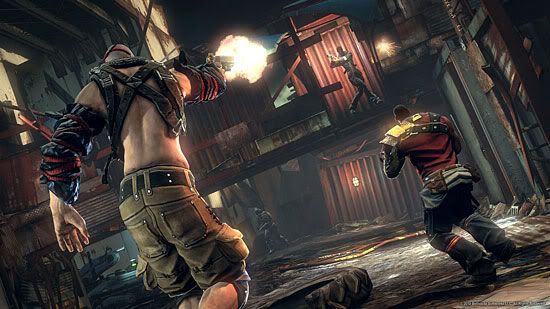 One more thing about uniqueness: in Brink you can customise your character to such an extent that it will be extremely easy to recognise buddies in the thick of it. Weight, height, colour, hair, facial hair, face paint, face masks, hats, trousers, coats, tattoos, all of these things can be added or removed. There are enough options for clans to kit themselves out in specific uniforms or two man teams to dress in such a way that they’ll be able to recognise each other at all times. It’s really cool. No, really cool.
One more thing about uniqueness: in Brink you can customise your character to such an extent that it will be extremely easy to recognise buddies in the thick of it. Weight, height, colour, hair, facial hair, face paint, face masks, hats, trousers, coats, tattoos, all of these things can be added or removed. There are enough options for clans to kit themselves out in specific uniforms or two man teams to dress in such a way that they’ll be able to recognise each other at all times. It’s really cool. No, really cool.
I absolutely loved playing this game – its graphical style is quite different to the glut of realistic shooters currently doing the rounds, looking like they’ve built a realistic looking game and then given it an animated finish. The multiplayer/solo blend feels like it’s going to blow a lot of minds and maybe bring some more players to the online fight than is otherwise usual and the sheer variety of missions and objectives is going to keep me playing for a very long time. But I do wonder about one thing. How will the hardcore react? What’s in it for them? In my own clan I’m lucky to have an ex-pro FPS gamer and a top five leaderboard placed Modern Warfare genius. At my level of skill, Brink has more than enough to keep me entertained for months, but these guys? I just don’t know how they’re going to react to it. The operative class is where I’d place one of them since he’s exactly the kind of player to storm through enemy lines and mix it up from behind, but the top five MW chap? I don’t know.
]]>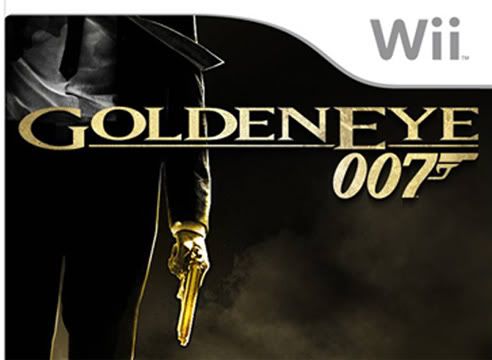
The impact Goldeneye had on me and, I suspect, every gamer in the universe at the time, was enormous. On consoles at least, there was very little out there that had as much multiplayer pull as Goldeneye. Today’s widely held belief that the best games are the games you can play with your friends, either online or in the same room, has its origins in a few titles, of which Nintendo can lay claim to two of the giants in Goldeneye and Mario Kart. Both titles are shoe ins for my Desert Island Games, as they will be for many a gamer of my generation I don’t doubt.
So you’d think I’d be well up for grabbing myself a copy of Nintendo’s remake of the N64 legend Goldeneye on the Wii. But I don’t know, I’m not really sure I want to go back there.
There’s something not quite right about bringing old games back from extinction, something gets washed away in all that water gushing under the time bridge. It makes me think of classic albums remastered and repackaged for the new generation. Take a classic like Hendrix’s Are You Experienced. It’s a brilliant record remastered or otherwise that stands the test of time and still makes young heads want to pick up the guitar and play. That’s what Mario Kart is to videogames, a timeless classic that’s still a favourite more than two decades after its inception. But Mario Kart has been repolished, tweaked and fiddled with so much that if you sat down and played the first and the current version next to each other you’d be laughing at how cruddy the original looks. In short, Mario Kart has been remastered to within an inch of its life.
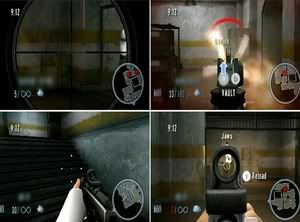
Goldeneye on the other hand, hasn’t changed a bit. It looks exactly like it did thirteen years ago. This is more like a remastering of Slayer’s Hell Awaits. When that baby landed, wow, what an album! Heavy, evil, fast, everything you wanted from the heaviest of heavy metal. Listen to it today and it’s a weak, slow, dated museum piece – I still love it but if I tried to push it onto a new gen metal nugget today I’d feel like my mum when I was young telling me AC/DC was ‘proper music’.
It’s the same game, people, the same game. Why on earth would you want to get this? Because you remember it as being a brilliant FPS game? Because thirteen years ago you and your mates used to cram round the TV, taking turns to be one of the four, keeping one eye on your opponents’ screens and one eye on your own? That was thirteen years ago, people. Times have changed.
I admit, I played this game a couple of times at Eurogamer 2010, and I did have a good laugh playing it (even when the Nintendo bod babysitting it thought the best way to show it off was to win the game in no mercy style), as did the people I played against, boys and men ranging from the age of twelve to forty. And it did bring back memories of youth, of spending Saturday nights hunting for the one shot kill golden gun till the small hours, keeping tabs on the scores (I’m kicking your arse 34-9 you losers!). But bring this game home today and expect it to wipe the floor with the current generation of FPS games? I don’t think so.

Maybe if this was Wii Ware it might be worth spending on it, but this is a full game, buy in the shops, £30+, take it home and shove it in the slot number. There is no way I’m going to chose this over Bad Company 2. And wandering around Brompton Hall, witnessing how many other FPS games are on show, just makes it more obvious I’m not going to be parting with cash for it.
And there’s another reason to worry. Though you can play it with the Wii bat and nunchuck, Nintendo were demoing it with the classic controller, suggesting it’s going to be a nightmare to play it with the motion sensor. You’re going to have to shell out more cash to relive those golden days proper.
It’s a worrying trend around Nintendo’s crop of games at this expo, lots of old games and gaming icons being rebooted: Kirby, Mario, Sonic, Donkey Kong, Goldeneye… What are they trying to say here, they haven’t got any new ideas?
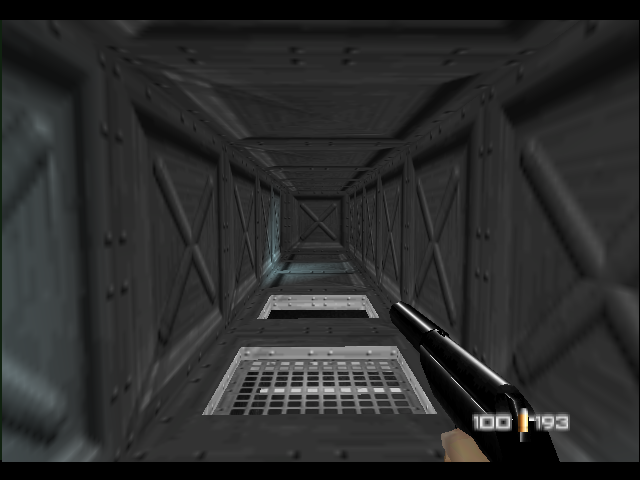
Alright, so Golden is still a damn good game, and if any of my mates happen to pick this up and get a load of classic controllers into the bargain I’d definitely be popping round to have a go, but I’m not going to suggest to you that you pre-order this and get the old gang back together. Better you meet them online with a current FPS fave, coz this old boy’s glory days are but a distant memory.
Then again, if anyone wants to give me a classic controller, I’d definitely play through the solo campaign. And there is going to be online multiplayer, so maybe I should just shut up about the split screen and get all excited about the online action…
]]>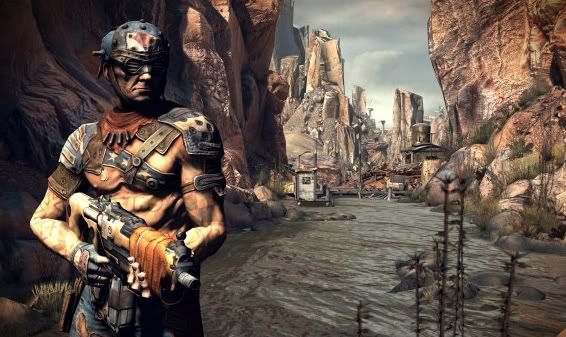 Of all the Dev Sessions going on over the weekend, the only one that got me interested was this one. Quake was the first LAN multiplayer game I ever played, staying late at the office just so I could pepper spray Dave from IT with a nail gun repeatedly (for ‘pepper spray Dave’, read ‘Dave annihilated everyone’. Gleefully). Doom was the first FPS I played. So when I found out id, makers of both FPS icons above were showing off Rage, their shiny new FPS, I was more than willing to stand in a queue for an hour just to watch someone else play it.
Of all the Dev Sessions going on over the weekend, the only one that got me interested was this one. Quake was the first LAN multiplayer game I ever played, staying late at the office just so I could pepper spray Dave from IT with a nail gun repeatedly (for ‘pepper spray Dave’, read ‘Dave annihilated everyone’. Gleefully). Doom was the first FPS I played. So when I found out id, makers of both FPS icons above were showing off Rage, their shiny new FPS, I was more than willing to stand in a queue for an hour just to watch someone else play it.
It’s been so long since these guys released a new FPS that I’ve had two kids and moved home eight times. Civilizations have fallen. Tony Blair went from never-heard-of-him to people’s choice to devil’s disciple and in that time Willits dropped nothing like a brand new shooter.
So Rage; it’s a new FPS from the people who brought you Quake. From the same people who created this huge beast of a game genre with the very first one, Wolfenstein. That’s big news people!
First impressions? It’s Fallout in first person. That’s exactly what it looks like, and I’m not the only one to think that because Willits says the very same thing later on in the session. It looks pretty damn cool. Willits rattles on about the virtual texture system that allows artists to make a game in a new way, I have no idea what it all means other than Rage looks lovely and there’s a special reason why. And that’s lovely as in you open your Christmas present and it’s your Hollywood sex symbol of choice in Xmas red and white underwear. Love. Ly.
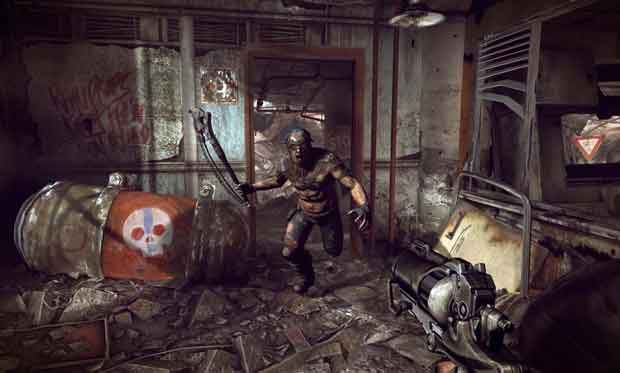 It’s classic videogame fodder, a shooter set in the not too distant future where you play as a survivor of a planet-crippling asteroid strike who emerges from an ark buried before the disaster when the plan to lay low for as long as necessary, ready to emerge and build a brave new world, was first hatched. And when you do surface, surprise surprise, the world is populated by bandits, renegades and mutants – all of whom are more than happy to open you up and splash around in your entrails.
It’s classic videogame fodder, a shooter set in the not too distant future where you play as a survivor of a planet-crippling asteroid strike who emerges from an ark buried before the disaster when the plan to lay low for as long as necessary, ready to emerge and build a brave new world, was first hatched. And when you do surface, surprise surprise, the world is populated by bandits, renegades and mutants – all of whom are more than happy to open you up and splash around in your entrails.
You ever wonder why mutants always want to kill people? You never see them wanting to kill each other, just normal people. Why haven’t they learned to integrate with the post-apocalyptic society? Your average future bad guy would have a lot of work for a gang of psychopaths with a taste for large scale, free for all, people killing. And besides all that, what about the ones that still have normal human mothers? Why did normal people shun them in the first place? They must be someone’s brother, sister, mother, father. Who would throw family out just because they’ve grown massive teeth and they keep looking at them funny? And how come they can be that madly intent on killing people but when they’re faced with an entirely different species of mutant, not a flicker of bloodlust?
Another first impression – the sounds of the guns are incredible. The assault rifle, the first gun we see in this little show, has a vicious, rasping, cavernous quality; a room-filling size. It sounds huge enough to deafen you. The pistol, that looks more like a flare gun its barrel’s so fat, has the kind of sound that makes you want to shoot off all your bullets in one go. Over your head, while shouting something in Mexican. Yummy.
And while I’m still grinning about that sound, Senior Producer Jason Kim, the man with the joy bat in his hands, takes control of a quad bike. Then he gets in a pick up truck. An armed pick up with chain guns and rockets mounted. Because there is a bit more going on in Rage than mere shooting the hell out of bad guys and genetic freaks. There’s racing around in loads of vehicles. Which, the developers are keen to make clear, is more of a side mission in the game than anything else. And they take that opportunity to stop the character in a street in Well Spring (your home base in the game) and have him play a little dice game called Tombstone, which looks somewhat like the Chess game in Star Wars. Neat.
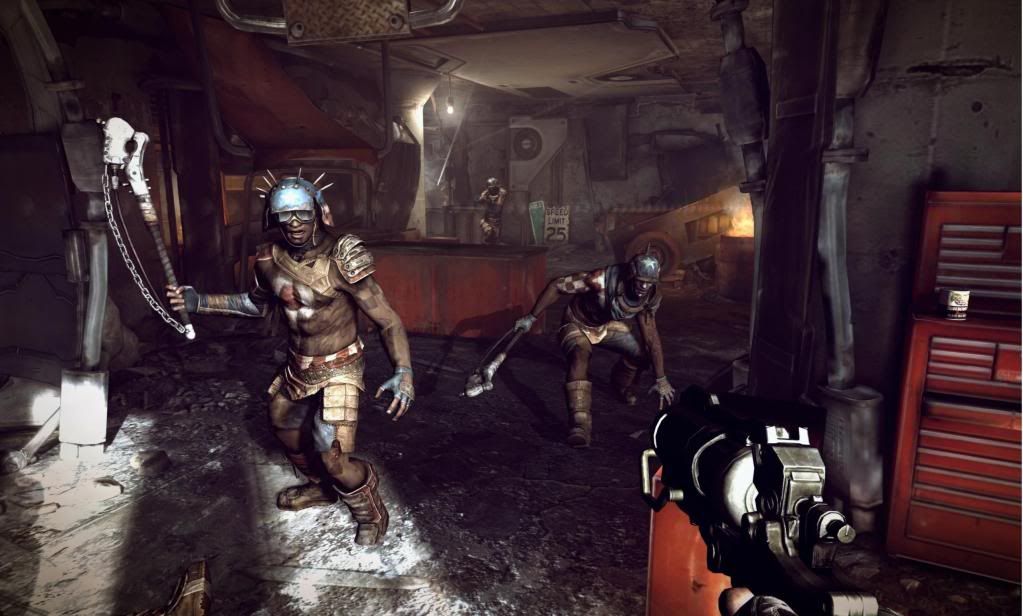 And while Jason opens up different parts of the game and wows us all with the neat blasting and killing, Willits talks about the ways in which players will be able to build special items in Rage through the acquirement of schematics. Find the right parts and you can engineer extras like boomerang blades, gun turrets, doorlock bombs and mini-gun mounted robotic spider sentries. I need to mention here a nice touch on the grenades, a time bar right in the middle of the screen that lets you know just when the thing’s going to go off – very handy.
And while Jason opens up different parts of the game and wows us all with the neat blasting and killing, Willits talks about the ways in which players will be able to build special items in Rage through the acquirement of schematics. Find the right parts and you can engineer extras like boomerang blades, gun turrets, doorlock bombs and mini-gun mounted robotic spider sentries. I need to mention here a nice touch on the grenades, a time bar right in the middle of the screen that lets you know just when the thing’s going to go off – very handy.
It looks like there is a hell of a lot going on in Rage. It feels like it will be as huge as Fallout 3 was, with plenty of off plot possibilities and all of it in 1st person.
As you’d expect from these guys, the weapons are monstrous and varied; different guns, different bullets, electric weapons, knives, rockets, every time they moved to another part of the game there were new weapons. And at the moment they’re not doing any limited weapon slots – find a gun, pick it up, it’s yours all day long. Oh yes, the Quake boys are back in town!
To finish off the show, id moved onto Dead City (where no one comes out alive), the place where all the mutants hang out. Not killing each other, of course, only normal people. These mutants do not look easy to deal with, I thought, and then a massive one appeared, three times the height of your character. It took a lot of work to kill it off, and as soon as he did the sound of something so big it would make you fill your knickers if you saw it for real began to rumble through the room and the demo faded to black just as this colossal humanoid rounded a corner and used the top of a 30 storey tower to steady itself. This game is going to do some damage to a lot of FPS franchises, might even knock a few spots off Gears Of War with these kind of skyscraper-sized knuckle-draggers inside.
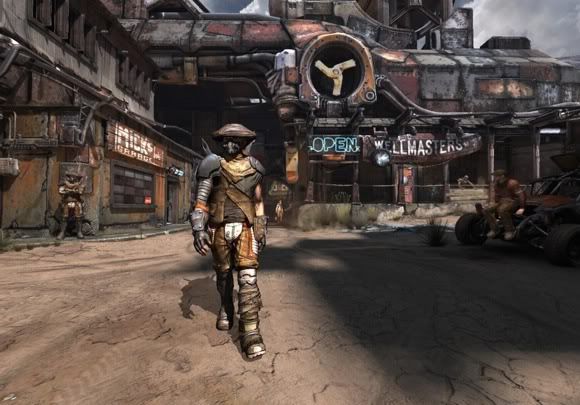 And now for some nerdy stuff: it’s 60 hertz on all platforms. The demo we saw was on the 360 (incredible). They’re keeping completely schtum about multiplayer till next year. The game world will be “open but directed” whatever that means. There is no morality system (who asked about that!?!). There will be Easter eggs. The 360 will need two discs, the PC and PS3 versions won’t. It will not run on 1080p for the PS3, however they were so sure of the PS3 version that the first time they let any journos play it was on a PS3. Willits did say that if you want to check out how Rage looks on all three platforms you just need to google Rage at Quakecon. So far, all we’ve found is the 2009 trailer videos and some iPhone Rage action. However, have a gander at some of the E3 2010 footage and you’ll be seeing pretty much the same stuff id were showing at Eurogamer 2010. It’s well worth tracking down because Rage looks set to redraw the FPS map with a much bigger pen.
And now for some nerdy stuff: it’s 60 hertz on all platforms. The demo we saw was on the 360 (incredible). They’re keeping completely schtum about multiplayer till next year. The game world will be “open but directed” whatever that means. There is no morality system (who asked about that!?!). There will be Easter eggs. The 360 will need two discs, the PC and PS3 versions won’t. It will not run on 1080p for the PS3, however they were so sure of the PS3 version that the first time they let any journos play it was on a PS3. Willits did say that if you want to check out how Rage looks on all three platforms you just need to google Rage at Quakecon. So far, all we’ve found is the 2009 trailer videos and some iPhone Rage action. However, have a gander at some of the E3 2010 footage and you’ll be seeing pretty much the same stuff id were showing at Eurogamer 2010. It’s well worth tracking down because Rage looks set to redraw the FPS map with a much bigger pen.

Bear with me fans of Dragon Age, I never played the first one so I have no idea how cool it was nor, for that matter, how bad it might have been. All I know is it was long and it had a huge back story.
Finding Dragon Age II in here took a day, and if anyone who went to Eurogamer 2010 and wanted to check this game out but never spotted it (it wasn’t listed in the guide map handed out on the way in), don’t worry too much, I doubt very much you would have been able to tell whether this new one’s going to be a winner from this demo.
The queues were three men deep (well, it was all men queueing when I was there), which doesn’t sound too bad considering the mile long line of gamer nerds stretching out round the back of Brink’s 8+ screens, but when each demo takes twenty minutes to play through, an hour of staring over someone else’s shoulder makes a man want the game at the end of it to be worth the wait. Which it wasn’t. What you get at the end of that hour is twenty minutes of hack and slash coupled with the pleasure of straining to hear any audio through the headsets provided. Now does that sound like worth an hour of your life waiting for? If it does, good for you. Off you toddle now, there’s nothing else to see here. You can pre-order it all over the net and it comes out in March next year. What else do you need to know?

And now they’ve gone, let’s get on with the bitching. Nah, just kidding, there’s nothing much to actually bitch about except that after the short demo I’ve come away with no idea whether this game’s good or not.
You start out dropped into a barren, scorched earth wilderness with a sidekick, after you’ve chosen which class you’re going to be – Rogue, Warrior, some kind of spiritual type that I can’t remember even though in the demo there was both a paladin and an apostle so it’s going to be one of those – and then the slashing kicks off. A few waves of Hurlock come at you, some with crossbows, others with swords, and it’s pretty easy to cut these grunts down. They look like a cross between the warrior gorillas from Planet Of The Apes and the freaky aliens in Pitch Black. So that’s alright then.
After watching everyone in front of me choose to be warriors, I plumbed for the more personally realistic rogue fella – two blades and lots of sneakiness. It didn’t make much difference, it was all button bashing mayhem whatever character you chose to play as.
 The face buttons have one for the basic attack and three for little extras that you could only pull off when their onscreen meters filled up. These you can upgrade and juggle as and when you level up with some weapon/upgrade tree menus.
The face buttons have one for the basic attack and three for little extras that you could only pull off when their onscreen meters filled up. These you can upgrade and juggle as and when you level up with some weapon/upgrade tree menus.
I hope this isn’t the finished product because the graphics in the cut scenes need sharpening up. There were plenty of blocky, jagged lines in every one, though the emotional expressions on the characters in those scenes looked really impressive, enigmatic even at times.
At least standing in the queue gave me an opportunity to see the differences between each character’s storyline, and I can’t say there was much of a difference to any of them in this demo. It’s completely linear, funnelling you along a path, popping up Hurlocks along the way, giving you a big, meaty Ogre to have a go at, adding new members to your team as you go and letting you jump from each one at will. Magic or sword, speed or strength, you had all the options at your finger tips for every fight.
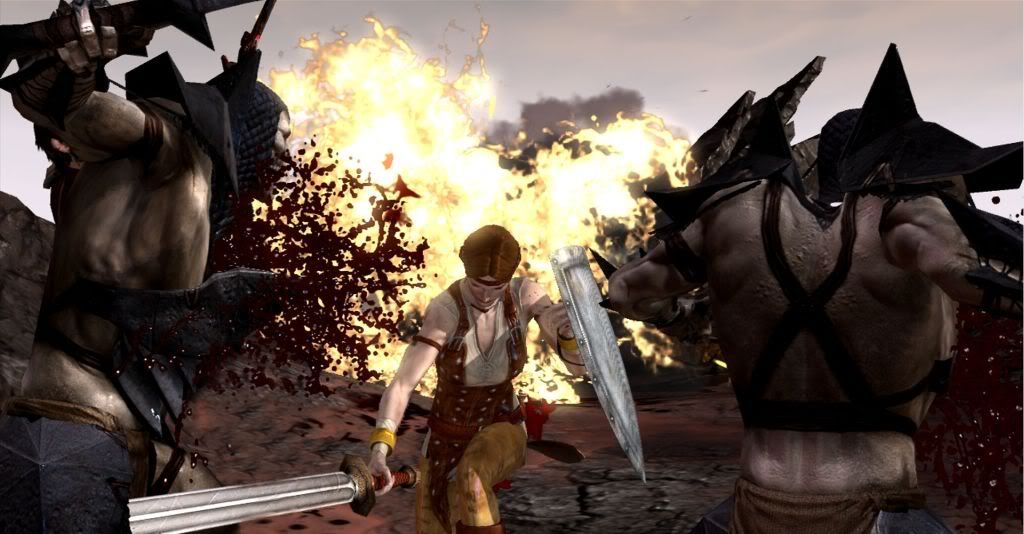 The Ogre was having a few problems, getting stuck mid-charge in a boulder but still running away like mad as if he’s doing the ogre Moonwalk. Then after a bit of this chopping and hacking a Dragon/woman shows up, flame grills all the bad guys and hands you a mission. And that’s all you get. It wasn’t exciting, thrilling or any other ing with a positive word in front of it. It was, to be frank, pretty standard gaming.
The Ogre was having a few problems, getting stuck mid-charge in a boulder but still running away like mad as if he’s doing the ogre Moonwalk. Then after a bit of this chopping and hacking a Dragon/woman shows up, flame grills all the bad guys and hands you a mission. And that’s all you get. It wasn’t exciting, thrilling or any other ing with a positive word in front of it. It was, to be frank, pretty standard gaming.
Now if you did play the first game and you can tell me it was awesome, had a great plot, loads of amazing battles, some jaw dropping attacks and weaponry and everything else then here’s hoping this game is every bit as cool. But there’s no way in the world anyone could make a judgement on this game after 20 mins except the flippant, the mad and the people who like to leave gobby messages in comment boxes. So I’m not going to.
]]>

